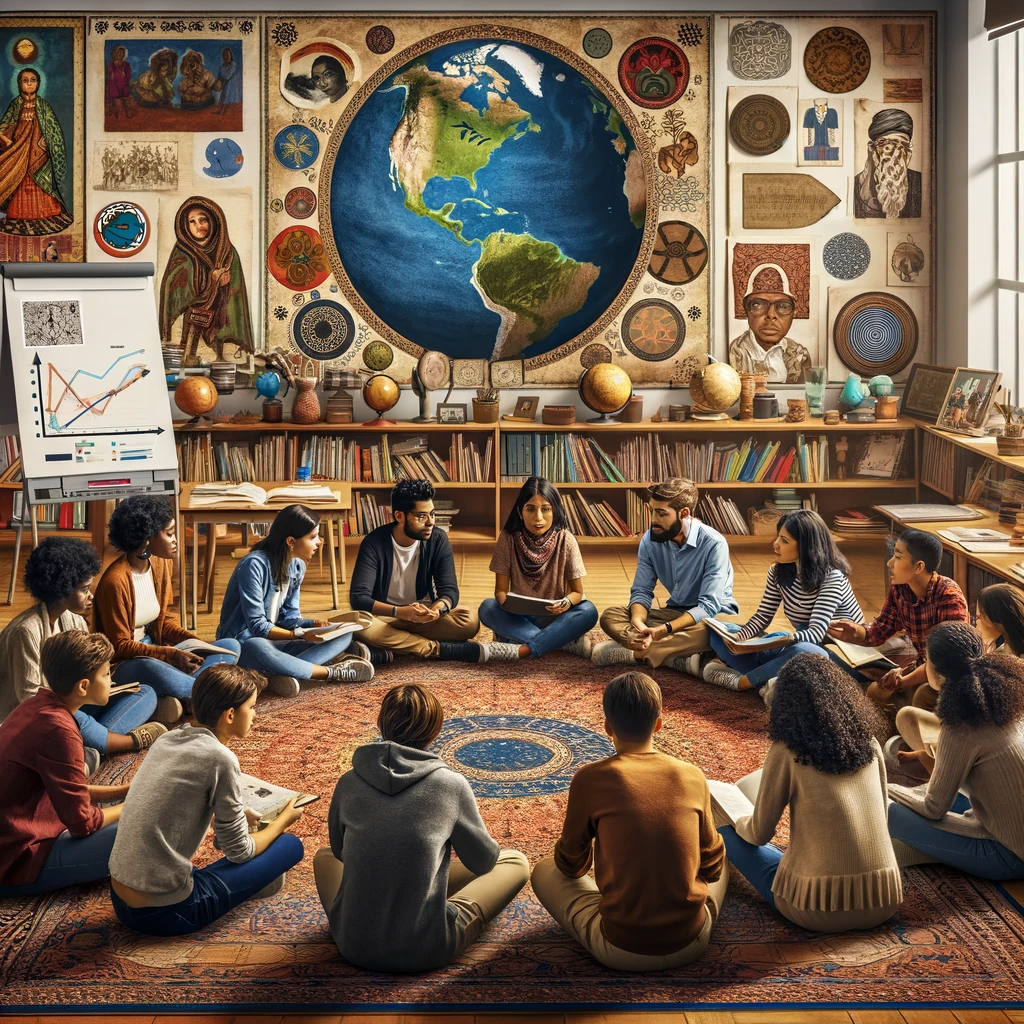Why Social Studies Matters to the Teaching of Reading
 Kevin Colleary, Ed.D.
·
8 minute read
Kevin Colleary, Ed.D.
·
8 minute read
There are big changes afoot in the United States concerning how we teach reading at the elementary level that may have a positive impact on the return of social studies to the elementary curriculum table. (Pondiscio, 2014; Knowledge Matters Campaign, 2021). A renewed focus on the importance of content knowledge and a demand for disciplinary literacy, spurred by the Common Core Standards in English/Language Arts, have helped build strong, challenging arguments against the exclusion of content (especially social studies and science) from our elementary schools. While the completely transformative curricular goals of the common core standards in reading and math may not have been realized and their use in many schools has been challenged, the standards in reading have had an influence in state standards documents and on pedagogy and curricular choices throughout the nation (Barnum, 2019; Loveless, 2021). A major difference in the demands of the Common Core State Standards for English Language Arts was for a greater emphasis on working with informational text and writing in the content areas (Common Core State Standards for English Language Arts, 2010). The grades 6-12 standards, entitled “Grades 6-12 Literacy in History/Social Studies, Science, & Technical Subjects” have a clear, explicit call for disciplinary literacy that is hardly being met by the dissolution of social studies in the elementary classroom. Disciplinary literacy is “the unique way that specific disciplines create, communicate and evaluate information.” (Shanahan & Shanahan, 2012) and demands that students are given practice with and specifically taught how to read historical, scientific, mathematical, etc. content.
Educators such as E.D. Hirsch have been arguing for a more rigorous and content focused curriculum (albeit from a distinctly Western-themed perspective) in our elementary schools since the 1980s (Hirsch, 1987). More recent work by journalist Natalie Wexler (2019) and cognitive scientist David Willingham (2009) and others have thrown new light on research which supports the power of teachers to increase comprehension, vocabulary and reading capacity by focusing on the teaching of content and the building up for students of a repository of knowledge. This work supports research reported many years ago by Merton (1968) in the science field and then by Walbert & Tsai (1983) on student achievement and content instruction. These researchers referred to a concept called the “Matthew Effect,” named after a passage from the Gospel of Matthew: “For whoever has will be given more, and they will have an abundance…” (Matthew 25:29) or “the rich get richer and the poor get poorer.” It argues that those students exposed to more information, more language, more content, more knowledge earlier will both learn more and be able to show more academic success as they progress through school as they are better able to ‘connect’ more and more complex knowledge to the concepts and knowledge experienced in their earliest years in school. Wexler shares the oft-used and commonly understood image of Velcro to help describe this process. Recent scholars have continued to present supportive data for the Matthew Effect and its impact on student reading achievement (Cunningham & Chen, 2014). “When young children are introduced to history and science in concrete and understandable ways, chances are they’ll be far better equipped to reengage with those topics with more nuance later on. At the same time, teaching disconnected comprehension skills boosts neither comprehension nor reading scores. It’s just empty calories. In effect, kids are clamoring for broccoli and spinach while adults insist on a steady diet of donuts” (Wexler, 2019). A growing chorus of educators and scholars from a wide variety of backgrounds is challenging the current status quo of an over reliance on skill and strategy work in the reading classroom and bemoaning the lack of content-rich curriculum firmly rooted in the content areas of science and social studies (Schmoker, 2020; Knowledge Matters Campaign, 2021).
This is also a key component of the current debate around using proven research-based strategies to improve student reading capacity nationally known as the “science of reading” (SOR). While much attention has been given to the call for increased work in phonemic awareness, phonics instruction and other foundational skills, an equally important element found in the SOR research is the demand to teach content and help students build knowledge, increase their academic vocabulary and allow their working memory to grow (The Reading League [TRL], 2022). As the scientific advisory committee of the Knowledge Matters Campaign have written:
The scientific research on reading and writing is clear: foundational skills including phonemic awareness, knowledge of sound-letter relationships, decoding and spelling skills, and fluency are necessary, but not sufficient for students to become fully literate. Systematically building knowledge is also vital, so students can understand and apply what they learn from the words on the page and can write in a way that shares their knowledge with others. In combination, these components build on and strengthen one another. Knowledgeable readers are more effective readers, and more effective readers can more easily build knowledge for reading and writing (Knowledge Matters Campaign, 2023).
In two powerful graphics which describe the research behind successful reading instruction that are increasingly becoming a part of professional development for teachers around the nation, we can see this clearly stated. In both the “Scarborough’s Reading Rope” graphic (2001) and the “simple view of reading (SVR)” graphic (Hoover & Gough, 1990) the topics of building content knowledge, academic vocabulary and working memory are clearly listed as critical building blocks for successful readers. In a paper about expanding our understanding of the science of reading, and especially of the simple view of reading, literacy scholars Nell Duke & Kelly B. Cartwright write:
Yet, there is a growing case in research for the importance of content knowledge to reading (e.g., Cabell & Hwang, 2020). Knowledge predicts reading ability even in models in which the original SVR components of decoding and listening comprehension are controlled (Hwang, 2020; Nusca, 1999; Talwar, Tighe, & Greenberg, 2018). Knowledge encompasses information and the organization of that information in long-term memory (Cook & Gueraud, 2005). Although there is no doubt that this construct is related to vocabulary (i.e., words in one’s vocabulary label concepts in one’s knowledge base), knowledge predicts unique variance in reading ability in models that include vocabulary (Ahmed et al., 2016; Cromley & Azevedo, 2007; Cromley, Snyder-Hogan, & Luciw-Dubas, 2010). Knowledge goes beyond just knowing specific word meanings to include knowledge of concepts, objects, and experiences (often discussed as script/ scenario knowledge or schemata). (Duke & Cartwright, 2021, p. S27-S28)
We must not forget, however, the important question of what content/which knowledge we need to help students build. Each state has robust social studies standards documents, such as the California Framework for History/Social Science (California Department of Education, 2000). But resources also exist at the national level including the C3 Framework, published in 2013 by the National Council for the Social Studies. The C3 Framework presents ways for parents, teachers and administrators to use state standards to incorporate high-quality social studies education in every school and community. The focus of the C3 framework is inquiry-based instruction. Another important publication in the social studies literature is from authors Kathy Swan, John Lee, & S.G. Grant who created an invaluable resource in 2018 entitled “Inquiry Design Model: Building Inquiries in Social Studies.” This text provides an excellent model for teaching social studies while incorporating and supporting the concept of inquiry-based instruction. This work followed an important and impressive effort that these scholars made in concert with hundreds of teachers as they created inquiry based curricular models for New York state – following the recommendations of the C3.
The current legislative effort in a large number of US states to limit, suppress or radically diminish teaching about specific historical topics such as racism is deeply troubling (Pendharker, 2022; Stout & Wilburn, 2022). These efforts remind us of the importance of all our efforts to make content choices that, while meeting state standards are also, as scholar Django Paris challenges us, culturally sustaining so that all students in our multilingual and multiethnic communities can thrive in school:
I offer the term culturally sustaining pedagogy as an alternative that I believe embodies some of the best past and present research and practice in the resource pedagogy tradition and as a term that supports the value of our multiethnic and multilingual present and future. The term culturally sustaining requires that our pedagogies be more than responsive of or relevant to the cultural experiences and practices of young people—it requires that they support young people in sustaining the cultural and linguistic competence of their communities while simultaneously offering access to dominant cultural competence. (Paris, 2012).
Duke & Cunningham have also written about the effects of culture and knowledge base in their argument on the importance of the SOR. They state:
Explicitly drawing practitioners’ attention to the role of cultural and other content knowledge may lead to more instruction aimed at building students’ knowledge, which research has found positively impacts reading development (e.g., Cabell & Hwang, 2020; Connor et al., 2017). It might also lead to a shift in thinking regarding reading difficulties, highlighting that reading difficulties are sometimes context dependent, occurring when there is a mismatch between the knowledge assumed by the author/ text (and teacher) and the knowledge of the reader. This in turn opens the door for considering how and why race, religious background, socioeconomic status, and other factors impact the reading process—why social justice concerns are relevant, even in understanding the process of reading. For example, readers who are rarely provided with opportunities to read texts that reflect their cultural background will experience the reading process differently than those with the privilege of a frequent match of their cultural background and the knowledge assumed by an author/text. (Duke & Cunningham, p. S28.)
We must utilize the current focus on the importance of scientific reading research and the need for culturally sustaining content to propel us in our continued challenge of the lack of social studies content in our elementary schools. It should also propel us to think about the teaching of reading in a way that supports content knowledge as a tool to help all students become better readers, writers and citizens.
REFERENCES
- Barnum, M. (2019, April 12). Nearly a decade later, did the common core work? New research offers clues. Chalkbeat. Retrieved from https://www.chalkbeat.org/2019/4/29/21121004/nearly-a-decade-later-did-the-common-core-work-new-research-offers-clues
- California Department of Education. (2000). History/Social Science Content Standards for California Public Schools, Kindergarten through Grade Twelve. Sacramento, CA. https://www.cde.ca.gov/be/st/ss/documents/histsocscistnd.pdf
- Cunningham, A.E. & Chen, Y. (2014). Matthew effects: The rich get richer in literacy. Encyclopedia of Language Development. SAGE Publications, Inc. Retrieved from https://moam.info/matthew-effects-the-rich-get-richer-in-literacy-_5a74d74d1723dd61321476ef.html
- Duke, N.K., and Cartwright, K.B. (2021). The Science of Reading Progresses: Communicating Advances Beyond the Simple View of Reading. Reading Research Quarterly 56(S1), S25– S44.
- Hirsch, E.D. (1987). Cultural literacy: What every American needs to know. Houghton Mifflin.
- Hoover, W. A., & Gough, P. B. (1990). The Simple View of Reading. Reading and Writing: An Interdisciplinary Journal, 2, 127-160. http://dx.doi.org/10.1007/BF00401799
- Knowledge Matters Campaign. (2021). Why knowledge matters. [program description] Retrieved from: https://knowledgematterscampaign.org/wp-content/uploads/2016/03/WhyKnowledgeMatters-1.pdf
- Knowledge Matters Campaign. (2023). Looking to research for literacy success. Retrieved from: https://www.ascd.org/blogs/looking-to-research-for-literacy-success
- Loveless, Tom. (2021) Between the state and the schoolhouse: Understanding the failure of common core. Harvard Education Press.
- Merton, R. K., (1968). The Matthew effect in science. Science 159:56–63. DOI:10.1126/science.159.3810.56
- National Council for the Social Studies. (2013). College, career, and civic life (C3) framework for social studies state standards: Guidance for enhancing the rigor of K-12 civics, economics, geography, and history [framework]. Retrieved from https://www.socialstudies.org/standards/c3
- National Governors Association Center for Best Practices, Council of Chief State School Officers. (2010). Common core state standards English Language Arts. [standards]. National Governors Association Center for Best Practices, Council of Chief State School Officers. http://www.corestandards.org/ELA-Literacy/
- Paris, D. (2012). Culturally sustaining pedagogy: A needed change in stance, terminology, and practice. Educational researcher, 41(3), 93-97.
- Pendharker, E. (2022 January 27). Efforts to ban critical race theory now restrict teaching for a third of America’s kids. Education Week. Retrieved from
- https://www.edweek.org/leadership/efforts-to-ban-critical-race-theory-now-restrict-teaching-for-a-third-of-americas-kids/2022/01?utm_source=nl&utm_medium=eml&utm_campaign=eu&M=64288686&U=868784&UUID=e7c8d6a0998b0ed813c23b801a588dc0
- Pondiscio, R. (2014). Literacy is knowledge: Why teaching reading means teaching content. City Journal. Winter 2014. Retrieved from https://www.city-journal.org/html/literacy-knowledge-13623.html
- The Reading League. (2022). Science of Reading: Defining Guide
- Scarborough, H. S. (2001). Connecting early language and literacy to later reading (dis)abilities: Evidence, theory, and practice. In S. Neuman & D. Dickinson (Eds.), Handbook for research in early literacy (pp. 97–110). Guilford Press.
- Schmoker, M. (2020 February 1). Radical reset: The case for minimalist literacy standards. Association for Supervision and Curriculum Development [website]. https://www.ascd.org/el/articles/radical-reset-the-case-for-minimalist-literacy-standards
- Shanahan, T., & Shanahan, C. (2012). What is disciplinary literacy and why does it matter? Topics in Language Disorders, 32(1), 7-18. DOI: 10.1097/TLD.0b013e318244557a
- Stout, C. & Wilburn, T., (2022 February 1). CRT Map: Efforts to restrict teaching racism and bias have multiplied across the US. Chalkbeat [website]. Retrieved from
- https://www.chalkbeat.org/22525983/map-critical-race-theory-legislation-teaching-racism
- Swan, K., Lee, J., & Grant, S. G., (2018). Inquiry design model: Building inquiries in social studies. National Council for the Social Studies (NCSS).
- Walberg, H. J., and Tsai, S. L. (1983). Matthew effects in education. American Educational Research Journal 20 (3), 359-373. https://www.researchgate.net/profile/Herbert-Walberg/publication/250184530_%27Matthew%27_Effects_in_Education/links/542011d70cf2218008d43991/Matthew-Effects-in-Education.pdf
- Wexler, N., (2019). The knowledge gap: The hidden cause of America’s broken education system…and how to fix it. Penguin Random House.
- Willingham, D. (2009). Why don’t students like school? A cognitive scientist answers questions about how the mind works and what it means for the classroom. Wiley.
___________________________
Some material in this blog has been published as part of:
Colleary, Kevin P., (2022). Ensuring a better future: why social studies matters. Gibbs-Smith Education.



